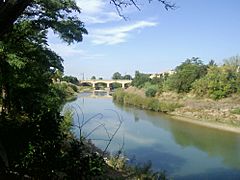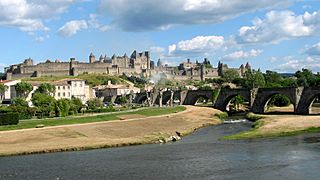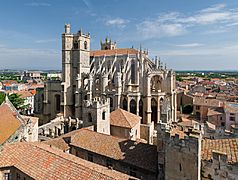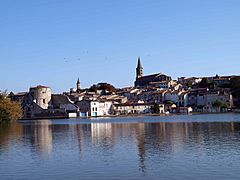Aude facts for kids
Quick facts for kids
Aude
|
|||
|---|---|---|---|
|
|||
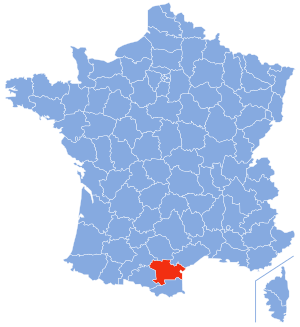
Location of Aude in France
|
|||
| Country | France | ||
| Region | Occitanie | ||
| Prefecture | Carcassonne | ||
| Subprefectures | Limoux, Narbonne | ||
| Area | |||
| • Total | 6,139 km2 (2,370 sq mi) | ||
| Population
(2014)
|
|||
| • Total | 365,478 | ||
| • Rank | 66th | ||
| • Density | 59.534/km2 (154.192/sq mi) | ||
| Demonym(s) | Audois, Audoises | ||
| Time zone | UTC+1 (CET) | ||
| • Summer (DST) | UTC+2 (CEST) | ||
| ISO 3166 code | FR-11 | ||
| Arrondissements | 3 | ||
| Cantons | 19 | ||
| Communes | 436 | ||
| Website | http://www.aude.fr/ | ||
Aude is a department in southern France. It is part of the Occitanie region. The department is named after the Aude river that flows through it.
People who live in Aude are called Audois (for men) and Audoises (for women) in French.
Contents
History of Aude
Aude was created in 1790 during the French Revolution. At that time, France was divided into new areas called departments. These new departments replaced the older provinces. Aude was formed from a part of the old province called Languedoc.
Initially, Aude was split into six smaller areas called districts. These districts were Castelnaudary, Carcassonne, Narbonne, Lagrasse, Limoux, and Quillan. Carcassonne was chosen as the main city, or capital, of the department.
Later, in 1800, these districts were changed into four arrondissements: Carcassonne, Castelnaudary, Limoux, and Narbonne. However, in 1926, the Castelnaudary arrondissement was removed.
Ancient Life in Aude
Scientists found an ancient skull in a cave near Tautavel. They named it Homme de Tautavel, which means "Tautavel Man." This cave is called Caune de l'Arago. The fossils found there are between 300,000 and 450,000 years old!
The skull belonged to a man who was in his twenties. He was about 1.65 meters tall and weighed around 45–55 kilograms. Other bone pieces were also found, including two jawbones. One belonged to a woman in her fifties, and the other to a man around 20 to 25 years old.
It seems these early humans might not have known how to use fire yet. They might have also eaten other humans (this is called cannibalism) or preferred to find already dead animals for food rather than hunt. Many animal bones were found in the cave too. These included bones from rhinoceros, horses, wild sheep (like Mouflon), Tahrs (which look like wild goats), Muskox (a type of cow-like animal), deer, and reindeer.
Scientists are still discussing if Tautavel Man is directly related to Neanderthals. Some think they are a type of Homo erectus, while others believe they are direct ancestors of Neanderthals, known as Homo heidelbergensis.
Geography of Aude
Aude covers an area of about 6,139 square kilometers (2,370 square miles). It is surrounded by several other departments in France. To the south, it borders Pyrénées-Orientales and Ariège. To the west, it borders Haute-Garonne. To the north, it borders Tarn and Hérault. On its eastern side, Aude has a coastline along the Gulf of Lion, which is part of the Mediterranean Sea.
 |
Haute-Garonne (Occitanie) |
Tarn (Occitanie) |
Hérault (Occitanie) |
 |
| Gulf of Lion | ||||
| Ariège (Occitanie) |
Pyrénées-Orientales (Occitanie) |
The most important river in the department is the Aude river. This river is so important that the department is named after it! Other important rivers are the Fresquel and the Orbieu. These two rivers are tributaries, meaning they flow into the Aude river.
The highest point in Aude is the Pic de Madrès. It is located in the French Pyrenees mountains. This peak is 2,469 meters (8,100 feet) high.
Administration of Aude
The Aude department is managed by a group called the Departmental Council of Aude. Their main office is in Carcassonne. Aude is part of the larger Occitanie region in France.
How Aude is Divided
Aude is divided into smaller administrative areas to help manage it. There are 3 main arrondissements (which are like large districts). Within these, there are 19 cantons (smaller areas for elections and local services). Finally, there are 436 communes (which are like towns or municipalities).
The three arrondissements are:
Population of Aude
In 2014, the Aude department had a population of 365,478 people. This means there were about 60 people living in every square kilometer. The arrondissement of Carcassonne is the largest, with 161,442 people. Narbonne has 159,569 people, and Limoux has 44,467 people.
Evolution of the population in Aude
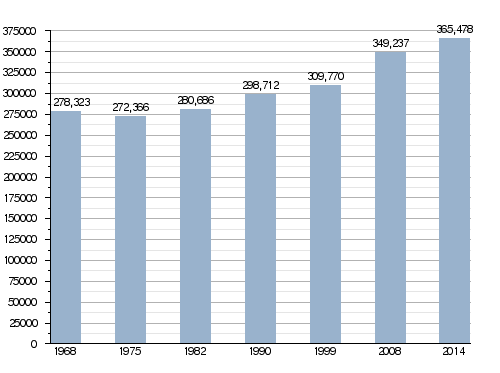
Here are some of the main cities in the Aude department:
| City | Population (2014) |
Arrondissement |
|---|---|---|
| Narbonne | 52,855 | Narbonne |
| Carcassonne | 45,941 | Carcassonne |
| Lézignan-Corbières | 11,248 | Narbonne |
| Castelnaudary | 11,096 | Carcassonne |
| Limoux | 10,275 | Limoux |
| Coursan | 5,916 | Narbonne |
| Port-la-Nouvelle | 5,635 | Narbonne |
| Sigean | 5,473 | Narbonne |
| Trèbes | 5,498 | Carcassonne |
Gallery
Related pages
Images for kids
-
Mountain landscape in the Razès at Quillan
-
Lightning during an autumn storm off the coast of Port-la-Nouvelle.
-
Skull of Tautavel Man discovered at Tautavel, not far from Aude
-
Entry to the port of Leucate
See also
 In Spanish: Aude para niños
In Spanish: Aude para niños




